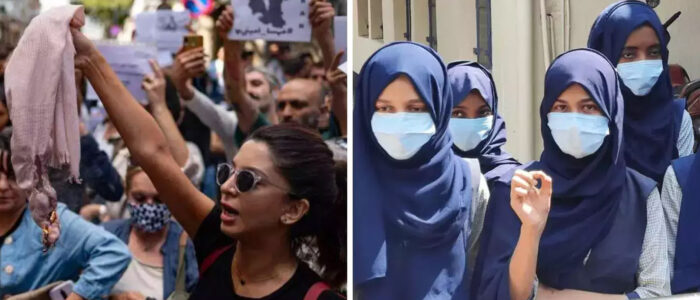Following the demise of Mahsa Amini at the hands of the Iranian morality police, thousands of women in the country have taken to the roads demanding reforms. The police indicted the young Kurdish woman for breaching Iran’s dress code regulations necessitating women to wear a headscarf to keep their hair covered, along with wearing loose-fitting outfits. To a distant observer, the scenario might appear quite contrary to what transpired earlier this year in India when Karnataka college barred hijab-clad Muslim students from entering the premises. The situation snowballed into state-wide “pro-hijab” protests in Karnataka against a state-enforced hijab ban. On the other hand, Indian media houses and people worldwide have supported the Iranian women’s “anti-hijab” demonstrations. Though the demands of the two resistances appear to be polar opposites, they might actually be for the same underlying cause.
In Iran, since the revolution of 1979, it has been obligatory for women to wear a headscarf in public. On top of it, an updated line of restrictions regarding acceptable attire was imposed under President Ebrahim Raisi on 15 August this year. On 16 September 2022, Ms Amini, who was visiting Tehran, was arrested near a local metro station by the country’s morality police on account of not wearing the headscarf modestly enough. She was allegedly tortured during her detention and passed away while in custody after falling into a coma.
The incident caused a country-wide uproar in Iran against the atrocity of state officials as masses kept chanting the slogan “Women, Life, Freedom”. The initial demonstration in this regard occurred following Ms Amini’s final rites when women took off their hijab as an act of “solidarity”. Subsequently, the protests metamorphosed into one of the gravest trials for the religious administration in the country after the revolution of 1979. The unparalleled protests have faced organised suppression by the state. Consequently, arrests of protestors have been made during these intense protests spanning more than six weeks. As per the Human Rights Activists News Agency (HRANA) of Iran, 284 individuals, including 45 children, have been slain during the state’s clampdown on the protests, while 35 security officials have also lost their lives.
It is crucial to understand that neither of the protests can be relegated to protests against or in favour of the idea of hijab. Instead, these women are vying against authoritarian states dictating the manner a woman may publicly appear.
Wide-ranging rallies persist, notwithstanding the Iranian supreme leader’s disdain for them. At the beginning of October, Ayatollah Ali Khamenei broke his silence and addressed the matter publicly. He placed the onus for the “riots” on the West for engineering the protests. However, many seem to ignore that Iranian women are not solely protesting against mandatory headscarves.
To a majority of the observers, including those who have witnessed the exact opposite in Karnataka, India, the Iranian demonstrations are viewed as the Muslim women’s protest against the notion of hijab. As one draws parallels between the hijab debates in Iran and India, it is interesting to note how the rightist Hindu elements under the Modi regime advocate Muslim women’s demonstrators in Iran. With the backdrop of India’s pro-hijab protests and hijab ban, various news sources in India showcase the Iranians’ taking to the streets as mere “anti-hijab” rallies. The protests in Iran seem to perfectly validate the narrative propagated by India’s religious majority that “hijab is an example of ‘radical Islam’”.
As for India, the country has been going through a hijab row of its own. Muslim students petitioned in the Karnataka High Court (HC) against the state government order banning headscarves in educational institutions. Petitioners asserted that the law did not stop students from joining classes while wearing a headscarf. They claimed that barring female students from entering classes on such grounds would correspond to an “infringement of fundamental rights”. Rather than only asking for their constitutional Right to Religious Freedom, the students maintained that the ban infringed upon their Right to Speech and Right to Privacy under Articles 19 and 21 of the Indian Constitution. Nevertheless, the HC upheld the ban on 15 March 2022, stating that the ban did not violate “Freedom of Speech or Expression”. Consequently, 26 appeals have been filed in the Supreme Court against the HC judgement. The Supreme Court has given a “split verdict” on the case where one of the two judges, Justice Sudhanshu Dhulia, has claimed that wearing a headscarf is a “matter of choice of Muslim Women, ‘nothing less than nothing more’”.
Still, whether it be India or Iran, many observers view these protests at face value as protests for or against headscarves. However, this conjecture misses the underlying dilemma by a long shot. It is crucial to understand that neither of the protests can be relegated to protests against or in favour of the idea of hijab. Instead, these women are vying against authoritarian states dictating the manner a woman may publicly appear. They are asking for their basic right to choose. In the case of India, the petitioners mentioned the right to wear hijab as their right to speech, expression, and privacy, which are fundamental human rights. Similarly, women in Iran are protesting against the forceful implementation of hijab laws and are now on the roads for individual, social, civil, and economic reforms. Protests against the hijab ban in Karnataka and against the Iranian regime necessitating Muslim women to wear hijab are two sides of the same coin. These reflect attempts to resist the policing of what women can or cannot wear in public. This also explains why many people across the world who support Muslim students’ right to wear headscarves in India also defend Iranian women’s right to freedom from oppression. As the protests are not merely pro-hijab or anti-hijab protests, supporting one does not take away from the other.
